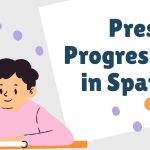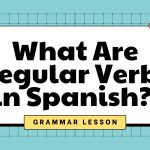Indicative conjugation in Spanish is all about stating facts and sharing what we know to be true. It helps us talk clearly about past, present, and future events. Getting good at these conjugations lets us handle different times and situations when we speak.
But there’s a tricky part: mixing it up with the subjunctive mood, which deals more with possibilities and what could be, can be tough for learners. Knowing when to use each can really sharpen your Spanish and make your conversations more effective.
So, diving into these differences is pretty crucial if you want to get better.
What Is The Difference Between Indicative And Subjunctive Mood?
Understanding the difference between the indicative and subjunctive moods is pretty important because they each play a unique role in how we talk about the world. The indicative mood is straightforward; it tells us about things that are actually happening or are definitely true. It deals with facts and the real world.

On the other hand, the subjunctive mood is about the hypothetical — it’s used when we’re talking about things that could happen, or when we wish things were different. It’s great for expressing doubts, hopes, or imaginary situations.
| Indicative Mood | Subjunctive Mood |
|---|---|
| Expresses facts and certainty → Juan vive en Madrid. (Juan lives in Madrid.) | Expresses doubt or uncertainty → No creo que Juan viva en Madrid. (I don’t think Juan lives in Madrid.) |
| Describes reality → Hace calor hoy. (It is hot today.) | Describes a possibility → Ojalá hiciera calor hoy. (I wish it were hot today.) |
| Used for actions that happened or will happen → Comí pizza ayer. (I ate pizza yesterday.) | Used for hypothetical or unreal situations → Si tuviera dinero, compraría una casa. (If I had money, I would buy a house.) |
| Follows expressions of certainty → Estoy seguro de que ella viene. (I’m sure she is coming.) | Follows expressions of doubt → Dudo que ella venga. (I doubt she is coming.) |
| Used with objective statements → El agua hierve a 100°C. (Water boils at 100°C.) | Used with subjective opinions → Es posible que el agua hierva más rápido en la montaña. (It’s possible that water boils faster in the mountains.) |
| Stays the same in affirmative and negative sentences → Creo que él tiene razón. (I think he is right.) / No creo que él tiene razón. (I don’t think he is right.) | Changes in negative sentences → Creo que él tiene razón. (I think he is right.) vs. No creo que él tenga razón. (I don’t think he is right.) |
| Used for scheduled events → El tren sale a las 10. (The train leaves at 10.) | Used for events that may not happen → Espero que el tren salga a tiempo. (I hope the train leaves on time.) |
| Follows “porque” (because) → Voy a la tienda porque necesito leche. (I’m going to the store because I need milk.) | Follows “para que” (so that) → Te llamo para que vengas temprano. (I call you so that you come early.) |
| Used with “mientras” to describe an ongoing action → Mientras estudiaba, escuchaba música. (While I was studying, I was listening to music.) | Used with “mientras” for conditions → Mientras tengas fiebre, quédate en casa. (As long as you have a fever, stay home.) |
| Expresses what is → Sé que ella está en casa. (I know she is at home.) | Expresses what might be → No sé si ella esté en casa. (I don’t know if she is at home.) |
Master the difference between preterite and imperfect with our guide
Moods in Spanish
When we talk about moods in Spanish, it’s really important to get the indicative mood. This mood is all about sharing facts and things we’re sure about. It includes different tenses and ways of conjugating verbs to match the timing or kind of action we’re talking about, like actions that are still going on.
There are also compound tenses in the indicative mood. These are used when you want to talk about something that was finished by a certain time or before something else happened.
Indicative Spanish: Tenses and conjugations
The indicative mood in Spanish is straightforward. It’s used to share facts and sure things. This mood has different tenses like the present, past (preterite and imperfect), future, and conditional. Each one fits a specific time and reality.
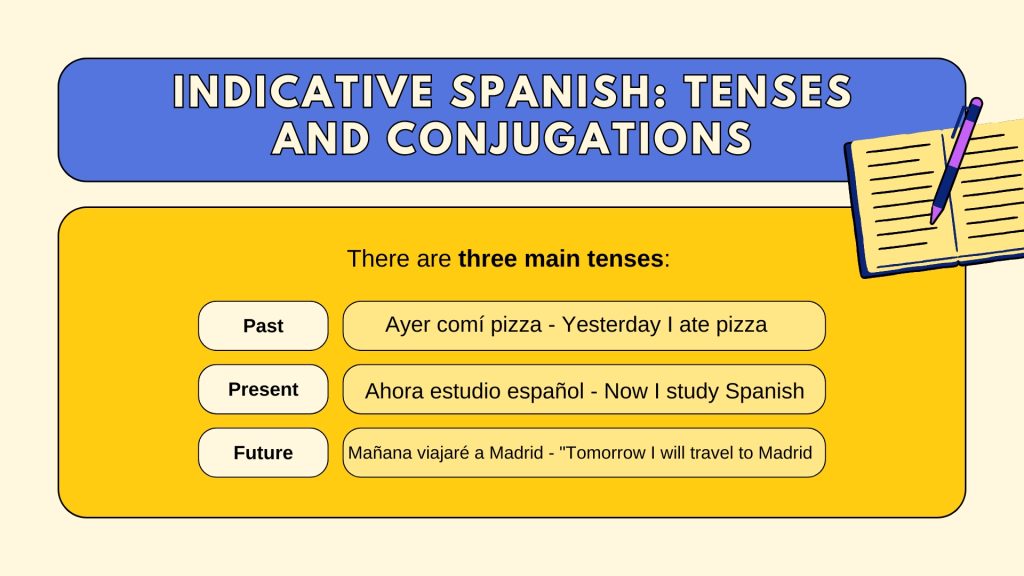
When you conjugate verbs in these tenses, you must adjust them based on who you’re talking about and how many people you mean. This helps make sure everyone knows exactly when things happen or the state things are in.
| Tense | Conjugation Example | English Meaning |
|---|---|---|
| Present | Yo hablo español. | I speak Spanish. |
| Preterite | Ayer comí pizza. | Yesterday, I ate pizza. |
| Imperfect | Cuando era niño, jugaba mucho. | When I was a kid, I played a lot. |
| Future | Mañana viajaré a Madrid. | Tomorrow, I will travel to Madrid. |
| Conditional | Si tuviera tiempo, estudiaría más. | If I had time, I would study more. |
| Present Perfect | He visto esa película. | I have seen that movie. |
| Past Perfect | Cuando llegué, ya habías salido. | When I arrived, you had already left. |
| Future Perfect | Para el lunes, habré terminado el proyecto. | By Monday, I will have finished the project. |
| Conditional Perfect | Habría comprado el coche si tuviera dinero. | I would have bought the car if I had money. |
| Simple Present for Facts | El agua hierve a 100°C. | Water boils at 100°C. |
Progressive Forms
Progressive forms in Spanish are used to talk about actions that are happening right now or were happening at some point in the past, or will be happening in the future. Think of it as a way to say what you’re doing, what you were doing, or what you will be doing, using the verb ‘estar’ (to be) plus another verb ending.
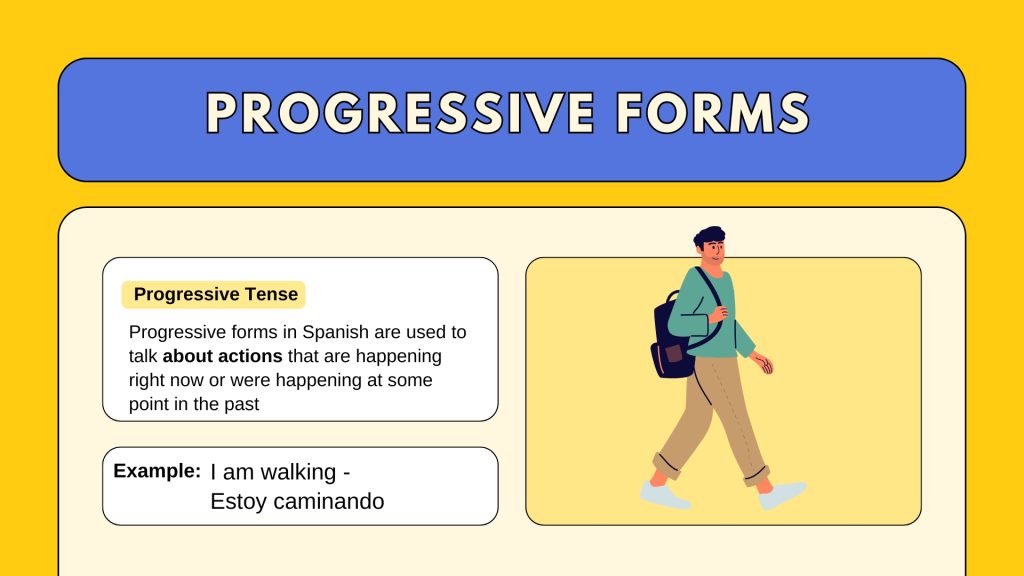
For example, ‘estoy hablando’ means ‘I am speaking,’ ‘estaba comiendo’ means ‘I was eating,’ and ‘estaré trabajando’ means ‘I will be working.’ It’s like snapping a picture of an action in motion, showing exactly when it’s taking place.
| Tense | Conjugation Example | English Meaning |
|---|---|---|
| Present Progressive | Estoy estudiando español. | I am studying Spanish. |
| Past Progressive | Estábamos viendo una película. | We were watching a movie. |
| Future Progressive | Estaré trabajando toda la tarde. | I will be working all afternoon. |
Compound Indicative Tenses
Building on what we know about progressive forms, let’s dive into compound indicative tenses in Spanish. These tenses help us talk about actions that are finished or will be finished by a certain time.
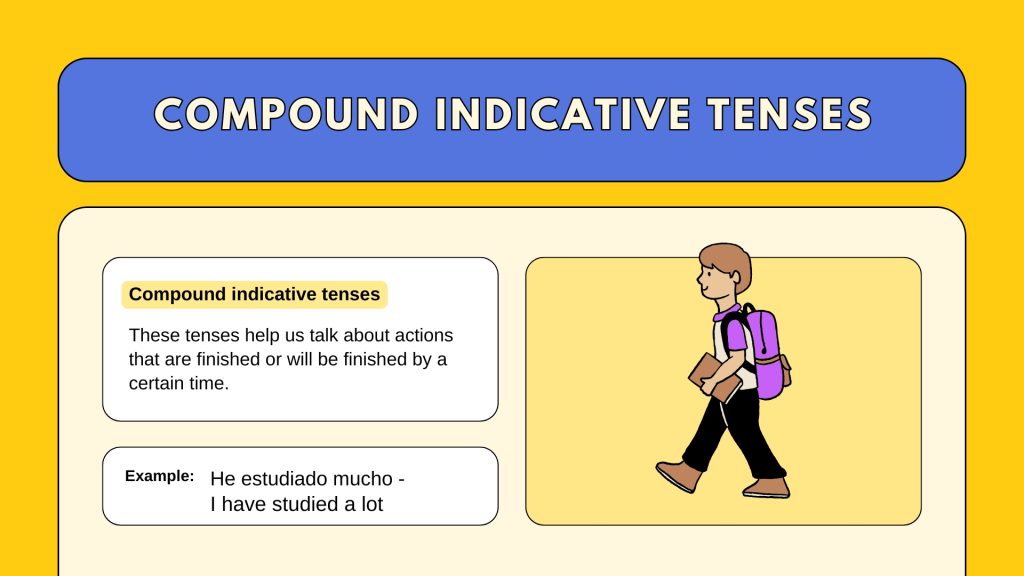
We mostly use the auxiliary verb ‘haber’ along with past participles. For example, the present perfect tense is formed with ‘he hablado,’ the past perfect with ‘había hablado,’ and the future perfect with ‘habré hablado.’
| Tense | Conjugation Example | English Meaning |
|---|---|---|
| Present Perfect | Hemos visitado Barcelona. | We have visited Barcelona. |
| Past Perfect | Habías aprendido mucho antes del examen. | You had learned a lot before the test. |
| Future Perfect | Habré terminado mi tarea para la noche. | I will have finished my homework by tonight. |
Ready to master AR verbs? Check out our full guide!
When to use Indicative Spanish
The indicative mood in Spanish is for stating facts or things you’re sure about. It’s all about what’s real and certain.
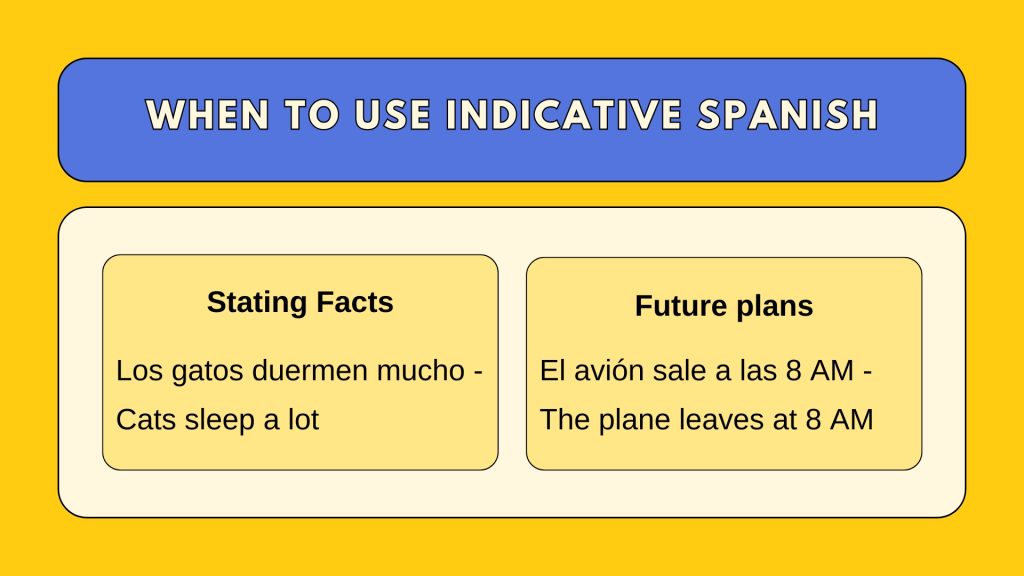
For example, if you say, ‘Ella estudia medicina,’ you’re simply stating that she studies medicine.
This is different from the subjunctive mood, used for doubts, possibilities, or what-ifs.
| Situation | Example | Why? |
|---|---|---|
| Stating facts | Los gatos duermen mucho. | Cats sleep a lot → It’s a fact. |
| Describing reality | Hoy hace frío. | Today is cold → A real situation. |
| Past actions | Fui al cine anoche. | I went to the movies last night → A completed action. |
| Future plans | El avión sale a las 8 AM. | The plane leaves at 8 AM → A scheduled event. |
| General truths | La tierra gira alrededor del sol. | The earth orbits the sun → A universal truth. |
Conclusion
The indicative mood in Spanish is crucial. It helps you state facts and be clear about what is true. This is different from the subjunctive mood, which you use for possibilities and guesses. To communicate well in Spanish, you need to know how to use the indicative mood properly. It lets you talk about things that happened, are happening, or will happen. Knowing when to use this mood makes your speech clear and direct, which is important whether you’re chatting casually or speaking formally.
So, it’s all about being clear and straightforward. When you get the hang of it, you will find it easier to express yourself in Spanish, no matter the situation.
Get inspired with the latest at Lingua Viva!
Carolina is a charming and lively member of Lingua Viva with 11+ years of teaching experience. She loves to teach students appropriate ways to communicate effectively in Spanish without the fear of making mistakes. She holds a professional teaching license and has a graduate degree with emphasis in Foreign Language.


